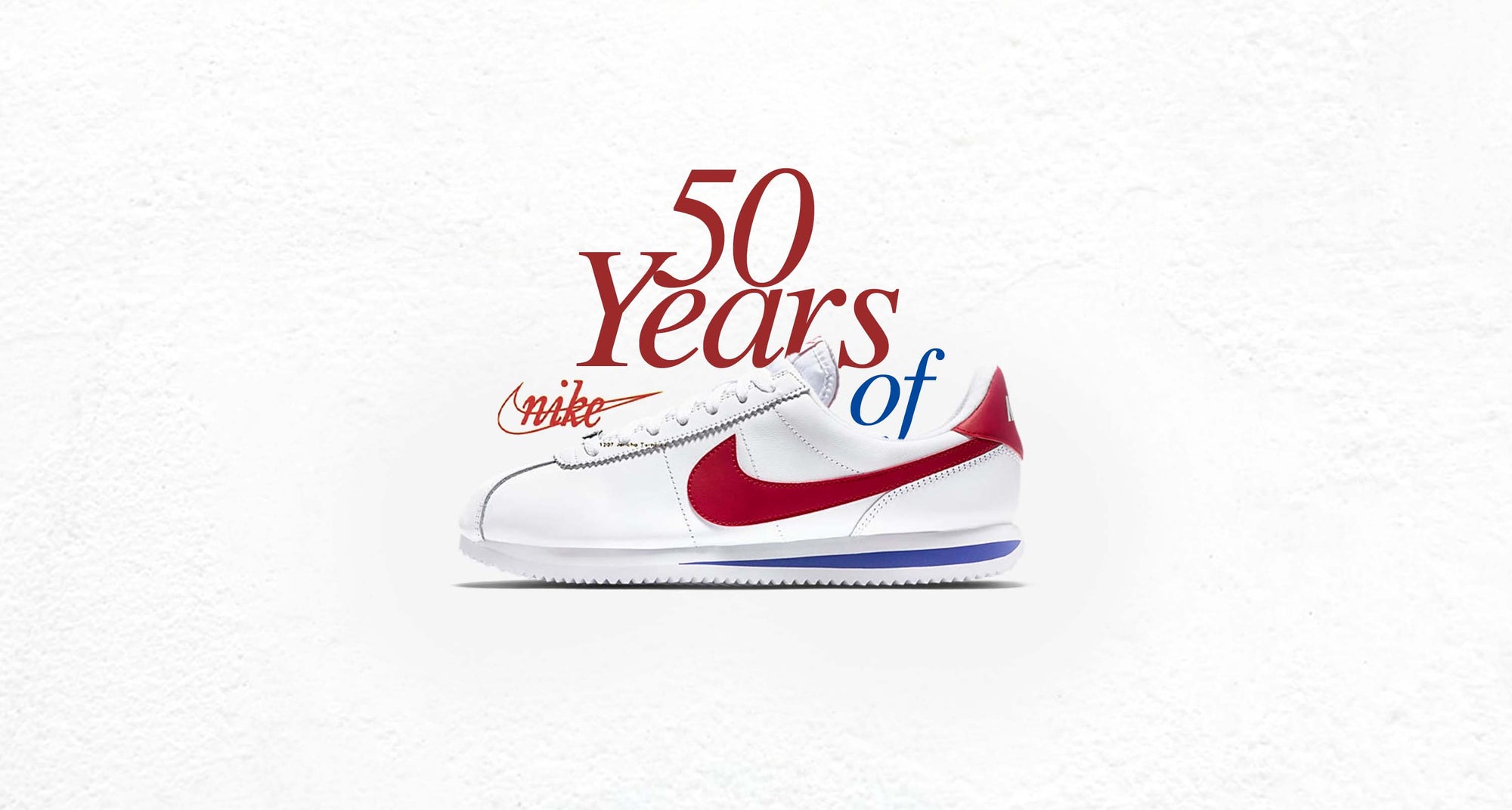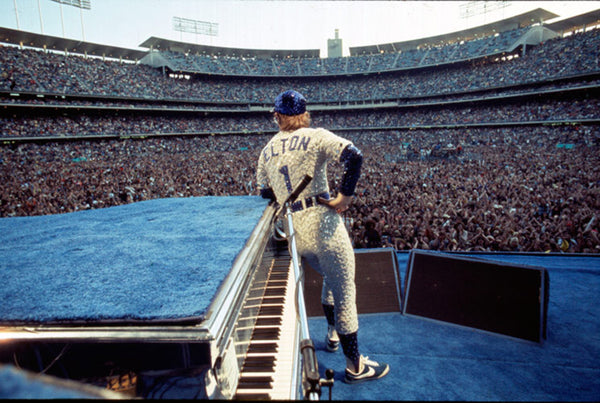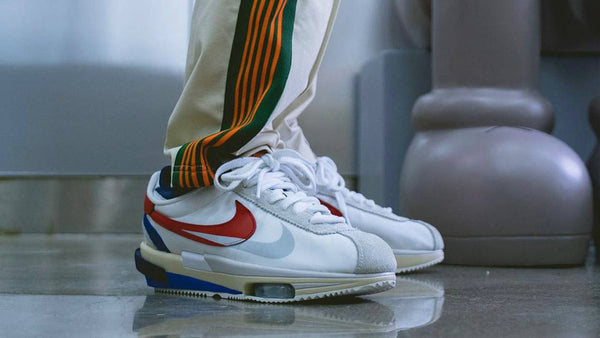
June 26, 2022 by Joey Birch
History of the Nike Cortez
2022 marks the 50th anniversary of one of Nike’s greatest sneakers, the Cortez. An iconic silhouette, the Cortez has evolved from being a technologically advanced running shoe (at the time it was released) to becoming a pop culture icon, finally resting on being an all-time classic.

Before Nike, came Blue Ribbon Sports. Founded by Phil Knight and the Olympic running coach Bill Bowerman, Blue Ribbon Sports was working alongside Onitsuka Tiger to distribute their sneakers within the US from Japan (a story best told within Phil Knight’s book ‘Shoe Dog’). After the duo had worked with Onitsuka Tiger (who also owns ASICS) for two years, Bowerman was allowed to utilise his designs and release a marathon-running sneaker of his own in conjunction with the Japanese brand.
Created in 1966, the sneaker was initially called the ‘TG-24’ and introduced a sponge midsole to assist with shock absorption as well as a herringbone-patterned outsole for additional grip. When the original design was first produced, Bowerman put an order in for 300 pairs of the running silhouette which would be distributed around the US to professional athletes, causing the popularity of the sneaker to reach new heights becoming one of the best-selling running sneakers of that year.

The following year, in 1967, Bowerman and Onitsuka wanted to change the name of their heavily praised release, and with the Mexico Olympics arriving in 1968, Bowerman decided to change the name to ‘TG-Mexcio’, which promoted some of the adverts for the sneaker to include the word ‘Mexico’ on the lateral side of the shoe.
However, Onitsuka Tiger decided that they weren’t happy with the name and once again made a change, this time looking to opt for the name ‘Aztec’, taking its inspiration from ancient Mexican history during the Aztec era. Despite the sneaker receiving its third name in two years, Onitsuka ran into further troubles, this time from one of their competitors, adidas.

At the time, adidas had released a running spike sneaker called the ‘Azteca Gold’ which featured a very similar shape to the Onitsuka spikes as well as similar overlays on the heel and used a similar name. With this being the case, Bowerman was tasked with finding a new name for the sneaker, this time choosing the name ‘Cortez’.
Acting almost as a final jab at adidas, the Cortez name was derived from the Spanish conquistador Hernan Cortes who led an expedition which brought the fall of the Aztec Empire in the 1500s.
Despite the name change, Onitsuka Tiger does still use the ‘Mexico’ name in their ‘Mexico 66’ running sneaker, perhaps a nod to the original 1966 TG-24.
During the late ‘60s, the Cortez wasn’t made of leather as we know it today. During its time being manufactured by Blue Ribbon Sports and Tiger, the shoe was made out of nylon resin that aimed to create a lightweight feel that still provides the ample support needed for a long-distance running sneaker. In an advert seen from this time by BRS (Blue Ribbon Sports), they call the technology ‘Swoosh Fiber’. While this is not mentioned as an inspiration behind the Nike ‘Swoosh’ we all know today, the name does seem to reference the iconic Nike logo in a way that seems too close to be a coincidence.
Thanks to the incredible feedback and success the sneaker saw during the Mexico Olympics, it grew further within the ‘jogging’ community and would go on to become one of Blue Ribbon’s and Onitsuka’s top-selling sneakers of all time.
While the growing success of Blue Ribbon Sports was expediential, the increased success wasn’t easy for Phil Knight. Constantly in contention with the bank, Knight was making late repayments meaning that his loans were not meeting his demand. At the same time, Onitsuka had begun to slow down their shipments of sneakers to BRS as well as taking more time to implement the improvements that Bowerman and Knight were sending over to Japan.
In an attempt to iron out the situation, Knight invited Onitsuka to visit the Blue Ribbon Sports headquarters in Oregan, later to be the home of Nike, at which point he realised that the brand had gone behind Knight’s back and cut deals with additional distributors in the US, thus shorting the supply to BRS.

Following this, in 1971, Phil Knight looked to have a rebrand and change the name of the company from Blue Ribbon Sports to Nike which was inspired by an earlier trip Knight had taken to Japan where he visited the temple of ‘Nike’ the Greek goddess of victory. For Nike to break away from Onitsuka Tiger and create their own line of sneakers, the two entered a three-year-long legal battle, with both brands looking to keep their most popular model - the Cortez.
Before the case was over, Bowerman had created the Nike Cortez by switching out the Onitsuka ‘Waves’ inspired by the waves on the Kobe shores, to the iconic Nike ‘Swoosh’ which was designed by Carolyn Davidson, inspired by the shape of a running motion, with the brand selling it under their own name in 1972.
During the 1972 Munich Olympics, U.S. track star Steve Prefontaine wore the Nike Cortez and became the shoe’s first athletic endorser. As a result, sales of the shoe skyrocketed to around $800,000 in the first year of release and would push Nike onto the trajectory to what it has become today.

The following year, at the Chicago Sporting Goods Association, Nike officially released three silhouettes to launch their new brand. The three silhouettes included the Marathon, Boston and the Cortez. At this time, Nike then released an advert for the Nike Cortez that included what they called ‘The Cortez Story’, which completely cut any mention of their previous partnership with Onitsuka Tiger. It was also here, that Nike released the first leather version of the Nike Cortez.

Finally, in 1974, the court case between Nike and Onitsuka Tiger was passed in favour of Nike, allowing them to continue with the ‘Cortez’ name, but ruling that both brands were still able to create a product with the same silhouette. As such, Tiger changed the name of their variant to “Tiger Corsair” which is still available today.
By 1975, three variants of the Nike Cortez were in production including the now-classic leather version as well as a suede variant and nylon finish - the nylon weighing in at around 0.34 KG, ‘the worst lightest running shoe’ as proclaimed by Nike at the time.

While the Cortez was a staple within the running community, 1976 saw it explode into pop culture. In an episode of Charlie’s Angels, the actress Farah Fawcett can be seen skating in a women’s version of the leather Nike Cortez titled the ‘Señorita Cortez’. Following the release, sales of the women’s sizing of the sneaker grew massively, with the image of Fawcett becoming iconic not only in Nike’s history, but sneaker history as a whole.
The advert was later recreated by Bella Hadid for the silhouette's 45th anniversary in 2017.

During the ‘80s, the Nike Cortez continued to be a huge success in pop culture, particularly finding its footing within the music industry. In the mid-'70s - early ‘80s Sir Elton John worked closely with Nike to create his own Cortez sneaker which featured the midsole design of the 1979 Nike Roadrunner.

During his 1980 world tour, John even went on to dedicate a song to “his good friends at Nike”, after trading tickets to his show for a reported $16,000 worth of Nike clothing. Following his dedication to the Swoosh, the artist put his foot on the piano he was playing on stage, all while wearing a pair of blue and white Nike Cortez.

By the latter half of 1980, Nike and their Cortez were world-renowned with a now magnitude of sneakers on offer including the Air Force 1 from 1982, the Air Jordan 1 in 1985 and the Air Max 1 in 1987. This time also saw the rise of East Coast rap music in which the Cortez played a big role being named the ‘Dopemans Nikes’ by NWA in their 1987 song ‘Dopeman’. The Cortez as a result became a staple part of LA culture, later inspiring artists such as Kendrick Lamar to collaborate on the silhouette that connects to his LA roots.

Fast forward to 1994, Nike is continuing to dominate the sneaker market. It also saw the release of one of, if not the, biggest sneaker moments in history. The film ‘Forrest Gump’ starring Tom Hanks saw a scene in which the main character, Forrest, is given a pair of the classic Nike’s by his love interest, Jennie. The scene is perfect product placement and sees Forrest going onto run across the United States wearing the sneaker, further advertising the running benefits they still held.
The sneaker played such a huge role in the film that they have since become synonymous with it much like the Air Jordan 4s worn by Spike Lee in the 1989 basketball film ‘Do The Right Thing’.
A similar appraisal for the OG silhouette was seen in Seinfeld with the character George Costanza opting to wear the sneaker regularly.
Since its release, the Nike Cortez has seemed to dip out of favour from the mainstream with attention moving to basketball sneakers and Air Max as time passed. Nevertheless, Nike has been able to keep the spirit of its very first silhouette alive, with many still holding it in high regard.

Countless colourways and iterations of the Cortez have been released over the years, including a magnitude of colourways and materials as well as other combinations similar to Sir Elton John’s mashup with Fragment creating the Roshe Cortez in 2015 which combined the Cortez and now infamous Roshe Run and even a high top chukka variant of the Cortez releasing the same year.
The classic OG leather variant of the Nike Cortez would go on to be officially retroed in 2016, releasing in the classic white, red and blue colourway as well as a clean black and white makeover.

In August 2017, Kendrick Lamar announced his move away from Reebok as he signed with Nike. Not two months later, in October, leaks spread of the first release between the two - the K-Dot Cortez. Dubbed the ‘DAMN’ colourway in honour of his latest album at the time, the release showcased a deep red upper with a black Swoosh and midsole. These were accompanied by two additional colourways of the sneaker, one of which was an all-white offering with ‘DAMN’ stencilled on the lateral side as well as an all-black pair with a white Swoosh and red detailing on the tongue and heel.
While 2018 saw two further colourways of the Lamar x Cortez amongst a myriad of additional colourways and collaborations, including Stranger Things in 2019, the sneaker once again began to wain in mainstream popularity.
With 2022 marking 50 years of the silhouette, could we once again see a resurgence?
At the time of writing this, we are yet to see much acknowledgement of the anniversary, despite releases for the Air Max 1 and AM 97 that also celebrate milestones this year.

However, that isn’t to say that Nike isn’t gearing up to celebrate the classic model in the latter half of 2022. Having re-released the women's ‘Señorita Cortez’ earlier this year as well as sharing official looks at the Nike SB ‘BRSB’ (AKA Blue Ribbon SB) which is a clear nod to Nike’s origins with the OG Cortez colourway and silhouette, it may simply be a matter of time.
While Nike hasn't made as much of a point of celebrating the anniversary of its oldest silhouette, other brands that are collaborating with Nike are set to release projects that are worth taking note of.

Set to release later in June, Union LA is once again collaborating with Nike following the release of the Passport Pack Dunks and Air Jordan 2. Arriving in three separate colourways, Union has taken the Cortez and used striped woven panels overlaid with suede sitting atop Crater Foam outsoles.

Secondly, images have emerged of Sacai’s FW22 lookbook, including a stacked Nike Cortez silhouette, similar to work they have done previously on the LD Waffle. Featuring a triple midsole as well as an exposed Air Unit under the toe and a double Nike Swoosh on the lateral side.
The Nike Cortez is a perfect example of timeless design. A sneaker that has been able to touch a variety of subcultures whilst enduring trends and constantly evolving tastes. As well as referencing Nike’s humble beginnings and long-lost partnership with Onitsuka Tiger, the Cortez may just be one of the most important sneakers of all time. Without it, we may never have the Swoosh we know and love today.